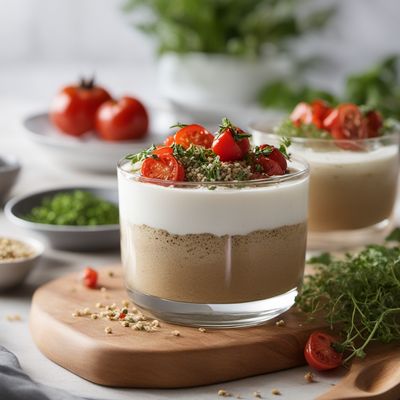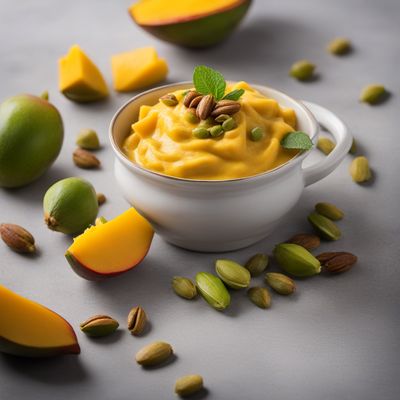
Ingredient
Strained yoghurt
Creamy Delight: Unveiling the Magic of Strained Yoghurt
Strained yoghurt is a thick and creamy dairy product made by straining regular yoghurt to remove the whey. This process gives it a velvety texture and a rich consistency. It has a slightly tangy and refreshing taste, with a hint of sweetness. The appearance of strained yoghurt is smooth and luscious, often resembling a thick custard or soft cheese. Its texture is dense and velvety, making it perfect for spreading, dipping, or incorporating into recipes.
Origins and history
Strained yoghurt has its roots in the Middle East and Mediterranean regions, where it has been consumed for centuries. It is believed to have originated in ancient Greece, where it was known as "oxygala." The straining method was used to preserve yoghurt and make it more concentrated, allowing it to last longer. Over time, strained yoghurt gained popularity in various cuisines, including Turkish, Lebanese, and Indian, and eventually spread to other parts of the world.
Nutritional information
Strained yoghurt is a nutritional powerhouse, packed with protein, calcium, and probiotics. It is low in fat and calories, making it a healthy choice for those watching their weight or looking to maintain a balanced diet.
Allergens
Strained yoghurt may contain milk allergens and is not suitable for individuals with lactose intolerance or dairy allergies.
How to select
When selecting strained yoghurt, opt for brands that use high-quality milk and have minimal additives or preservatives. Look for a thick and creamy consistency, as well as a tangy aroma. Check the label for the presence of live and active cultures, ensuring the yoghurt contains beneficial probiotics.
Storage recommendations
Store strained yoghurt in an airtight container in the refrigerator. It can be kept for up to two weeks, but its quality is best within the first week. Avoid freezing strained yoghurt, as it may alter its texture and consistency.
How to produce
To make strained yoghurt at home, start by pouring regular yoghurt into a cheesecloth-lined strainer or a fine-mesh sieve. Place the strainer over a bowl to catch the whey. Allow the yoghurt to strain in the refrigerator for several hours or overnight until it reaches the desired thickness. Discard the whey and transfer the strained yoghurt to a container for storage.
Preparation tips
Strained yoghurt can be enjoyed on its own as a creamy snack or used as a versatile ingredient in both sweet and savory recipes. It can be used as a healthier alternative to sour cream, mayonnaise, or cream cheese in dips, dressings, and spreads. It adds richness and creaminess to smoothies, desserts, and baked goods. When using strained yoghurt in cooking, it is important to note that it may curdle at high temperatures, so it is best to add it towards the end of the cooking process or use it in cold preparations.
Culinary uses
Strained yoghurt is commonly used in Mediterranean and Middle Eastern cuisines. It is a key ingredient in dishes like tzatziki, a refreshing cucumber and garlic dip, and labneh, a creamy cheese-like spread. It can be incorporated into marinades for tenderizing meats or used as a base for creamy salad dressings. In desserts, strained yoghurt adds a delightful tanginess to cheesecakes, frozen yoghurt, and creamy fruit parfaits.
Availability
Strained yoghurt is widely available in grocery stores and supermarkets worldwide. It is also easy to find in specialty stores that focus on Mediterranean or Middle Eastern products.
More ingredients from this category
Recipes using Strained yoghurt » Browse all

Macedonian-style Croquette Skewers
Savory Macedonian Croquette Delight

Jordanian-style Spaghetti with a Twist
Savory Spaghetti Delight: A Jordanian Twist on a Classic Italian Dish

Arab-Style Margherita Pizza
Middle Eastern Twist: Arab-Style Margherita Pizza

Arab-Style Breakfast
Aromatic Morning Delight: Arab-Inspired Breakfast

Nouvelle Manakish: A Modern Twist on a Lebanese Classic
Flavors of Lebanon Reimagined: Nouvelle Manakish

Cretan Twist on Manchester Tart
Cretan Delight Tart: A Fusion of British and Cretan Flavors

Balkan Delight Sponge Cake
Balkan Sunshine Cake: A Sweet Delight from the Balkan Peninsula

Omani-style Chalupa
Savory Omani Chalupa Delight

Homemade Mango Shrikhand
Mango Bliss: A Delectable Homemade Shrikhand Recipe

Moroccan-inspired Tiramisù
Spiced Delight: Moroccan Tiramisù

North African Spiced Pasta with Lamb
Saharan Delight: Spiced Lamb Pasta with a North African Twist

Arab-style Cordon Bleu
Middle Eastern Delight: Stuffed Chicken Cordon Bleu with a Twist


